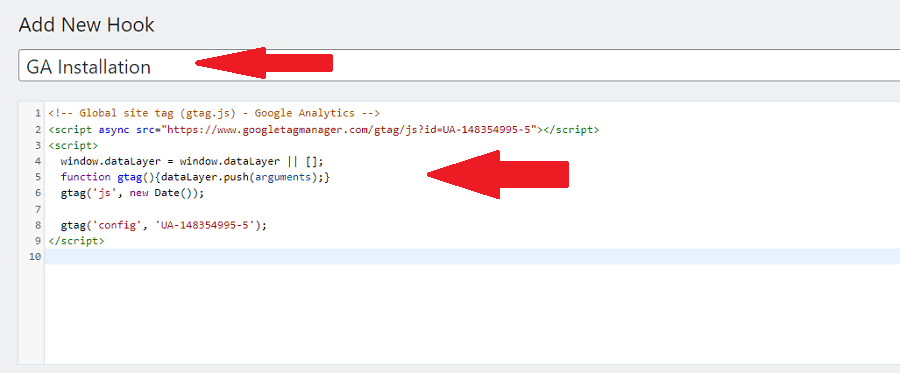Integrating Google Analytics with GeneratePress is a crucial step for tracking website performance, user behavior, and other key metrics. GeneratePress, a lightweight and versatile WordPress theme, offers multiple ways to seamlessly incorporate Google Analytics. This article explores three effective methods to achieve this integration, ensuring that you can make data-driven decisions to enhance your site’s functionality and user experience.

Why Integrate Google Analytics with GeneratePress?

Integrating Google Analytics with your GeneratePress theme is essential for obtaining valuable insights into your website’s performance. Google Analytics provides detailed reports on traffic sources, user behavior, conversion rates, and more. With this data, you can optimize your content, improve user experience, and make informed decisions about marketing strategies.
When using GeneratePress, integrating Google Analytics becomes straightforward, thanks to the theme’s compatibility and flexibility. By following the methods outlined in this article, you can ensure accurate tracking and leverage the full potential of Google Analytics.
Method 1: Using the GeneratePress Theme Options

GeneratePress offers built-in options to add custom scripts, making it easy to integrate Google Analytics without additional plugins. This method is ideal for users who prefer a lightweight setup and want to avoid plugin conflicts or bloat.
- Accessing the Customizer: Navigate to your WordPress dashboard, go to Appearance > Customize, and open the Customizer.
- Inserting the Tracking Code: Within the Customizer, select the ‘Additional CSS/JS’ option. Paste your Google Analytics tracking code into the ‘Head Scripts’ section.
- Publishing Changes: Save and publish your changes to apply the tracking code to your website.
This method ensures that your tracking code is loaded efficiently, directly from the theme’s options. It’s a simple and effective way to start tracking your site’s performance with Google Analytics.
Method 2: Utilizing a Plugin for Google Analytics

For those who prefer using plugins, several excellent options simplify Google Analytics integration with GeneratePress. Plugins can offer additional features and enhanced functionality beyond basic tracking.
- Choosing a Plugin: Popular plugins like ‘MonsterInsights’ or ‘Google Site Kit’ provide easy integration with Google Analytics.
- Installing the Plugin: Install and activate your chosen plugin from the WordPress plugin repository.
- Connecting to Google Analytics: Follow the plugin’s setup wizard to connect your Google Analytics account. Most plugins offer step-by-step instructions to ensure a smooth integration.
- Configuring Settings: Customize the plugin settings to fit your tracking needs, such as enabling advanced tracking options or integrating with other Google services.
Plugins offer user-friendly interfaces and additional features, such as real-time analytics and enhanced e-commerce tracking, making them a popular choice for many users.
Also Read: Top 5 Passion.io Alternatives You Can’t Ignore in 2024!
Method 3: Adding Google Analytics Code Manually

For users who prefer more control, adding the Google Analytics tracking code manually is a viable option. This method requires editing theme files but provides a direct and customizable approach.
- Locating the Header File: Access your theme files via the WordPress dashboard or an FTP client. Navigate to Appearance > Theme Editor and open the ‘header.php’ file.
- Inserting the Tracking Code: Paste your Google Analytics tracking code right before the closing
</head>tag. - Saving Changes: Save the updated file and check your website to ensure the tracking code is correctly implemented.
Manual integration allows for precise placement of the tracking code and can be useful for advanced users who want to fine-tune their analytics setup.
Comparing the Methods
Each method of integrating Google Analytics with GeneratePress has its advantages and considerations. Here’s a comparison to help you choose the best approach for your needs:
| Method | Pros | Cons |
|---|---|---|
| Theme Options | Lightweight, no plugins required, easy to implement | Limited to basic tracking |
| Plugin | User-friendly, additional features, enhanced tracking | Potential for plugin conflicts, may slow down site |
| Manual | Full control, customizable | Requires theme file edits, higher risk for errors |
Common Issues and Troubleshooting Tips
Integrating Google Analytics can sometimes lead to issues, such as tracking errors or data discrepancies. Here are some common problems and troubleshooting tips:
- Tracking Code Not Working: Ensure the tracking code is correctly placed and not duplicated.
- Data Discrepancies: Check your Google Analytics settings and filters to ensure accurate data collection.
- Plugin Conflicts: Disable other plugins to identify conflicts and resolve issues.
By addressing these common issues, you can ensure your Google Analytics integration functions smoothly and provides accurate data.
Best Practices for Google Analytics Integration
To make the most of your Google Analytics integration with GeneratePress, follow these best practices:
- Regularly Update Tracking Code: Ensure your tracking code is up-to-date to take advantage of new features and improvements.
- Utilize Enhanced Features: Enable advanced tracking options, such as event tracking and e-commerce analytics, to gain deeper insights.
- Monitor Performance: Regularly review your analytics data to identify trends and areas for improvement.
Following these best practices will help you leverage the full potential of Google Analytics and improve your website’s performance.
Also Read: Top Webinar Software for 2024: 7 Best Platforms Reviewed with Pros & Cons
Advanced Tips for Maximizing Google Analytics
For users looking to take their Google Analytics integration to the next level, consider these advanced tips:
- Custom Dashboards: Create custom dashboards in Google Analytics to track key metrics relevant to your goals.
- Goals and Conversions: Set up goals and conversion tracking to measure the success of specific actions on your site.
- Segmenting Data: Use data segments to analyze specific subsets of your audience for more targeted insights.
These advanced tips can help you gain more detailed insights and make data-driven decisions to optimize your website.
FAQs
Q: Why is it important to integrate Google Analytics with GeneratePress?
A: Integrating Google Analytics with GeneratePress allows you to track website performance, understand user behavior, and make informed decisions to improve your site.
Q: Can I use multiple methods simultaneously to integrate Google Analytics with GeneratePress?
A: While it’s possible, it’s generally best to stick with one method to avoid conflicts and ensure accurate data tracking.
Q: What should I do if my Google Analytics data is not showing up?
A: Double-check that your tracking code is correctly implemented and not duplicated. Verify your Google Analytics settings and filters.
Q: Are there any risks associated with manually adding the Google Analytics tracking code?
A: Manual addition requires editing theme files, which can lead to errors if not done correctly. It’s recommended for advanced users comfortable with code.
Q: How often should I update my Google Analytics tracking code?
A: Regularly check for updates to your tracking code to ensure you’re using the latest version with all available features and improvements.

